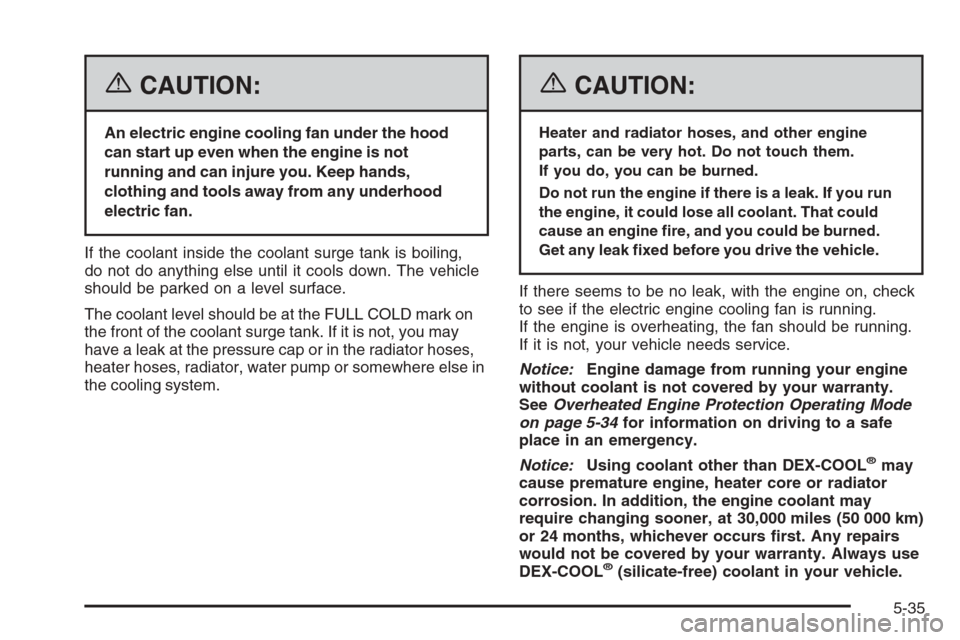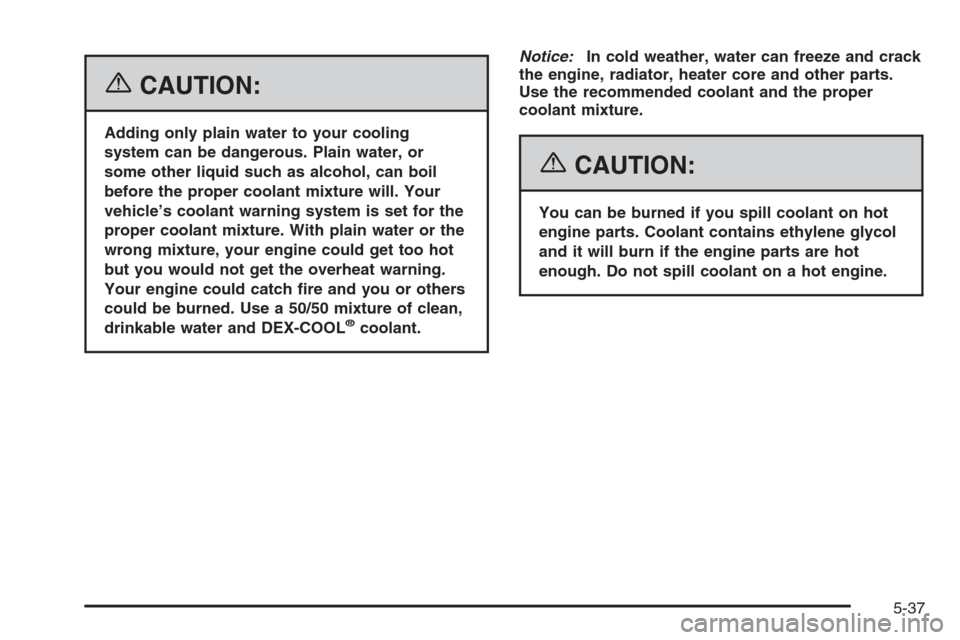2006 CHEVROLET CORVETTE engine overheat
[x] Cancel search: engine overheatPage 311 of 426

{CAUTION:
An electric engine cooling fan under the hood
can start up even when the engine is not
running and can injure you. Keep hands,
clothing and tools away from any underhood
electric fan.
If the coolant inside the coolant surge tank is boiling,
do not do anything else until it cools down. The vehicle
should be parked on a level surface.
The coolant level should be at the FULL COLD mark on
the front of the coolant surge tank. If it is not, you may
have a leak at the pressure cap or in the radiator hoses,
heater hoses, radiator, water pump or somewhere else in
the cooling system.
{CAUTION:
Heater and radiator hoses, and other engine
parts, can be very hot. Do not touch them.
If you do, you can be burned.
Do not run the engine if there is a leak. If you run
the engine, it could lose all coolant. That could
cause an engine �re, and you could be burned.
Get any leak �xed before you drive the vehicle.
If there seems to be no leak, with the engine on, check
to see if the electric engine cooling fan is running.
If the engine is overheating, the fan should be running.
If it is not, your vehicle needs service.
Notice:Engine damage from running your engine
without coolant is not covered by your warranty.
SeeOverheated Engine Protection Operating Mode
on page 5-34for information on driving to a safe
place in an emergency.
Notice:Using coolant other than DEX-COOL
®may
cause premature engine, heater core or radiator
corrosion. In addition, the engine coolant may
require changing sooner, at 30,000 miles (50 000 km)
or 24 months, whichever occurs �rst. Any repairs
would not be covered by your warranty. Always use
DEX-COOL
®(silicate-free) coolant in your vehicle.
5-35
Page 313 of 426

{CAUTION:
Adding only plain water to your cooling
system can be dangerous. Plain water, or
some other liquid such as alcohol, can boil
before the proper coolant mixture will. Your
vehicle’s coolant warning system is set for the
proper coolant mixture. With plain water or the
wrong mixture, your engine could get too hot
but you would not get the overheat warning.
Your engine could catch �re and you or others
could be burned. Use a 50/50 mixture of clean,
drinkable water and DEX-COOL
®coolant.Notice:In cold weather, water can freeze and crack
the engine, radiator, heater core and other parts.
Use the recommended coolant and the proper
coolant mixture.
{CAUTION:
You can be burned if you spill coolant on hot
engine parts. Coolant contains ethylene glycol
and it will burn if the engine parts are hot
enough. Do not spill coolant on a hot engine.
5-37
Page 343 of 426

Tire Pressure Monitor System
The Tire Pressure Monitor System (TPMS) on your
vehicle, uses radio and sensor technology to check tire
pressure levels. Sensors, mounted on each tire and
wheel assembly, transmit tire pressure readings to a
receiver located in the vehicle. The TPMS sensors
transmit tire pressure readings once every 60 seconds
while the vehicle is being driven and once every
60 minutes when the vehicle is stationary for more than
15 minutes. Using the Driver Information Center (DIC),
tire pressure levels can be viewed by the driver. The
TPMS also uses the DIC to warn the driver when air
pressure, in one or more of the tires, falls below 24 psi
(164 kPa) or is above 42 psi (290 kPa). For additional
information and details about the DIC operation and
displays seeDIC Controls and Displays on page 3-48
andDIC Warnings and Messages on page 3-53.
A low tire pressure warning light also appears on the
instrument panel cluster when a low tire condition exists.
The low tire pressure warning light will be shown each
time the engine is started and stays on until the low tire
condition is corrected.
Each tire, including the spare (if provided), should be
checked monthly when cold and in�ated to the in�ation
pressure recommended by the vehicle manufacturer
on the vehicle placard or tire in�ation pressure label.(If your vehicle has tires of a different size than the size
indicated on the vehicle placard or tire in�ation pressure
label, you should determine the proper in�ation pressure
for those tires.)
As an added safety
feature, your vehicle has
been equipped with a
tire pressure monitoring
system (TPMS) that
illuminates a low tire
pressure telltale when one
or more of your tires is
signi�cantly under-in�ated.
Accordingly, when the low tire pressure telltale
illuminates, you should stop and check your tires as
soon as possible, and in�ate them to the proper
pressure. Driving on a signi�cantly under-in�ated tire
causes the tire to overheat and can lead to tire failure.
Under-in�ation also reduces fuel efficiency and tire
tread life, and may affect the vehicle’s handling
and stopping ability.
Please note that the TPMS is not a substitute for proper
tire maintenance, and it is the driver’s responsibility to
maintain correct tire pressure, even if under-in�ation
has not reached the level to trigger illumination of
the TPMS low tire pressure telltale.
5-67
Page 417 of 426

Engine
Air Cleaner/Filter.........................................5-25
Battery.......................................................5-45
Check and Service Engine Soon Light............3-42
Coolant......................................................5-29
Coolant Heater............................................2-24
Coolant Temperature Gage...........................3-41
Drive Belt Routing.......................................6-15
Engine Compartment Overview......................5-12
Exhaust.....................................................2-36
Oil .............................................................5-16
Oil Life System...........................................5-23
Oil Pressure Gage.......................................3-45
Overheated Protection Operating Mode...........5-34
Overheating................................................5-32
Starting......................................................2-23
Entry/Exit Lighting...........................................3-19
Event Data Recorders (EDR)............................. 7-9
Extended Mobility Tires....................................5-62
Extender, Safety Belt.......................................1-21
Exterior Lamps...............................................3-15
Exterior Lighting Battery Saver..........................3-19F
Filter
Engine Air Cleaner......................................5-25
Finish Damage...............................................5-90
Flashers, Hazard Warning.................................. 3-6
Flash-to-Pass................................................... 3-9
Flat Tire........................................................5-81
Floor Mats.....................................................2-51
Fluid
Automatic Transmission................................5-28
Manual Transmission....................................5-28
Power Steering...........................................5-40
Windshield Washer......................................5-41
Fog Lamp Light..............................................3-46
Fog Lamps ....................................................3-17
Front Air Dam................................................2-21
Fuel............................................................... 5-4
Additives...................................................... 5-6
California Fuel.............................................. 5-5
Filling a Portable Fuel Container....................5-10
Filling Your Tank........................................... 5-7
Fuels in Foreign Countries.............................. 5-6
Gage .........................................................3-47
Gasoline Octane........................................... 5-5
Gasoline Speci�cations.................................. 5-5
5
Page 421 of 426

Mirrors
Automatic Dimming Rearview with Compass....2-41
Automatic Dimming Rearview with
OnStar
®and Compass..............................2-38
Manual Rearview Mirror................................2-38
Outside Automatic Dimming Mirror.................2-44
Outside Convex Mirror.................................2-44
Outside Power Heated Mirrors.......................2-43
MyGMLink.com................................................ 7-3
N
Navigation/Radio System, see
Navigation Manual.......................................3-99
New Vehicle Break-In......................................2-21
Normal Maintenance Replacement Parts............6-14
O
Odometer......................................................3-34
Off-Road Recovery..........................................4-15
Oil
Engine.......................................................5-16
Engine Oil Pressure Gage............................3-45
Oil, Engine Oil Life System..............................5-23Older Children, Restraints................................1-22
One-to-Four Shift Light....................................3-38
Online Owner Center........................................ 7-3
OnStar
®System, see OnStar®Manual...............2-45
Other Warning Devices...................................... 3-6
Outlet Adjustment............................................3-30
Outlet(s), Accessory Power...............................3-24
Outside
Automatic Dimming Mirror.............................2-44
Convex Mirror.............................................2-44
Power Heated Mirrors..................................2-43
Overheated Engine Protection Operating Mode.....5-34
Owner Checks and Services.............................. 6-8
Owners, Canadian............................................... ii
P
Paint, Damage...............................................5-90
Park (P)
Shifting Into................................................2-33
Shifting Out of............................................2-35
Parking
Brake........................................................2-33
Over Things That Burn.................................2-36
Parking Your Vehicle.......................................2-35
9